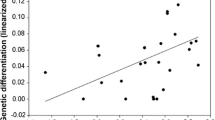Abstract
The genetic structure of ten natural populations of Arabidopsis thaliana (L.) Heynh. at eight isozyme loci was studied. The populations were located in the northern part of the species range, 200 km from the north to the south along the Onega Lake coast in Karelia. Considerable genetic diversity (P 99% = 43.7, H obs = 0.003) was revealed that is not typical of populations of self-pollinating plant species. A direct correlation between the proportion of polymorphic loci and geographical latitude was shown (r = 0.68; P < 0.05). It is suggested that a high polymorphism level in Karelian Arabidopsis thaliana (L.) populations increasing from the south to the north is due to extreme environmental conditions in the northern part of the species range. The distribution of genetic diversity within and between populations is typical of self-pollinating species: the larger part of the total diversity resides among populations (G ST = 0.583).
Similar content being viewed by others
REFERENCES
Kranz, A.R., Spontaneous and Induced Genetic Resources in Arabidopsis: Model and Tool to Study Certain Problems of Gene Exploration, AIS, 1976, no. 13, pp. 12-17.
Ratcliffe, D., Adaptation to Habitat in a Group of Annual Plants, J. Ecol., 1961, vol. 49, pp. 189-203.
Cetl, I., Genoclinal Character of Flowering-Time Variability in Arabidopsis thaliana (L.) Heynh., AIS, 1978, no. 5, pp. 92-109.
Mair, E., Zoologicheskii vid i evolyutsiya (Zoological Species and Evolution), Moscow: Mir, 1968.
Carson, H.L., Genetic Conditions Which Promote or Retard the Formation of Species, Cold Spring Harbor Symp. Quant. Biol., 1959, vol. 24, pp. 87-105.
Dobzhansky, T., Genetics and the Origin of Species, New York, 1951, 3rd ed.
Levontin, R.C., The Adaptations of Populations to Varying Environments, Cold Spring Harbor Symp. Quant. Biol., 1957, vol. 22, pp. 395-408.
Levontin, R.C., The Genetic Basis of Evolutionary Change, New York: Columbia Univ., 1974.
Korochkin, L.I., Serov, O.L., Pudovkin, A.I., et al., Genetika izofermentov (Genetics of Isozymes), Moscow: Nauka, 1977.
Gomes, M.F. and Abbot, R.J., Genotypic Diversity in British Populations of Arabidopsis thaliana Based on a Survey of Isozyme Variation, AIS, 1987, no. 23, pp. 25-30.
Fuglevitcz, A. and Kilian, A., Variability of Enzymatic Systems in Natural Populations of Arabidopsis thaliana in Poland, AIS, 1985, no. 22, pp. 87-90.
Grover, N.S., Characterization of Arabidopsis thaliana Ecotypes on the Basis of Genetic Variation at Ten Isozyme Loci, AIS, 1975, no. 12, pp. 19-21.
Jacobs, M. and Schwind, F., Biochemical Genetics of Acid Phosphatase Isozymes in Arabidopsis thaliana (L.) Heynh., AIS, 1976, no. 13, pp. 56-76.
Abbot, R.J. and Gomes, M.F., Population Genetic Structure and Outcrossing Rate of Arabidopsis thaliana (L.) Heynh., Heredity, 1989, vol. 62, no. 3, pp. 411-418.
Zhivotovsky, L.A., Statistical Methods for Analyzing Gene Frequencies in Natural Populations, Itogi Nauki Tekh., Ser.: Obshch. Genet., Moscow: VINITI, 1983, vol. 8, pp. 76-104.
Swofford, D.L. and Selander, R.B., BIOSYS-1: A FORTRAN Program for the Comprehensive Analysis of Electrophoretic Data in Population Genetics and Systematics, J. Hered., 1981, vol. 72, pp. 281-283.
Nei, M., Analysis of Gene Diversity in Subdivided Populations, Proc. Natl. Acad. Sci. USA, 1973, vol. 70, pp. 3321-3323.
Li, C.C., First Course in Population Genetics, Pacific Grove, California: Boxwood, 1976.
Kranz, A.R. and Kircheim, B., Genetic Resources in Arabidopsis, AIS, 1987, no. 24.
Cetl, I., Genetic Polymorphism for Alleles of Flowering-Time in Natural Populations of Arabidopsis thaliana (L.) Heynh., AIS, 1990, no. 27, pp. 27-43.
Nei, M., Genetic Distance between Populations, Am. Nat., 1972, no. 106, p. 283.
Gottlieb, L.D., Electrophoretical Evidence and Plant Populations, Prog. Phytocem., 1981, vol. 7, pp. 1-46.
Hamrick, J.L., Linhart, Y.B., and Mitton, J.B., Relationship between Life History Characteristic and Electrophoretically Detectable Genetic Variation in Plants, Annu. Rev. Ecol. Syst., 1979, vol. 10, pp. 173-200.
Trofimovskaya, A.Ya., Yachmen' (Barley), Leningrad: Kolos, 1972, p. 99.
Kilian, A. and Maluszynski, M., Genetic Variability of Arabidopsis thaliana Populations from Regions of Different Pollution Level, AIS, 1987, no. 25, pp. 57-66.
Weir, B.S., Allard, R.W., and Kahler, A.L., Further Analysis of Complex Allozymes Polymorphisms in Barley Population, Genetics, 1974, no. 3, pp. 911-919.
Zhivotovsky, L.A., Integratsiya poligennykh sistem v populyatsiyakh (Integration of Polygenic Systems in Populations), Moscow: Nauka, 1984.
Author information
Authors and Affiliations
Rights and permissions
About this article
Cite this article
Fedorenko, O.M., Savushkin, A.I. & Olimpienko, G.S. Genetic Diversity in Natural Populations of Arabidopsis thaliana (L.) Heynh. from Karelia. Russian Journal of Genetics 37, 162–167 (2001). https://doi.org/10.1023/A:1009041922186
Issue Date:
DOI: https://doi.org/10.1023/A:1009041922186




